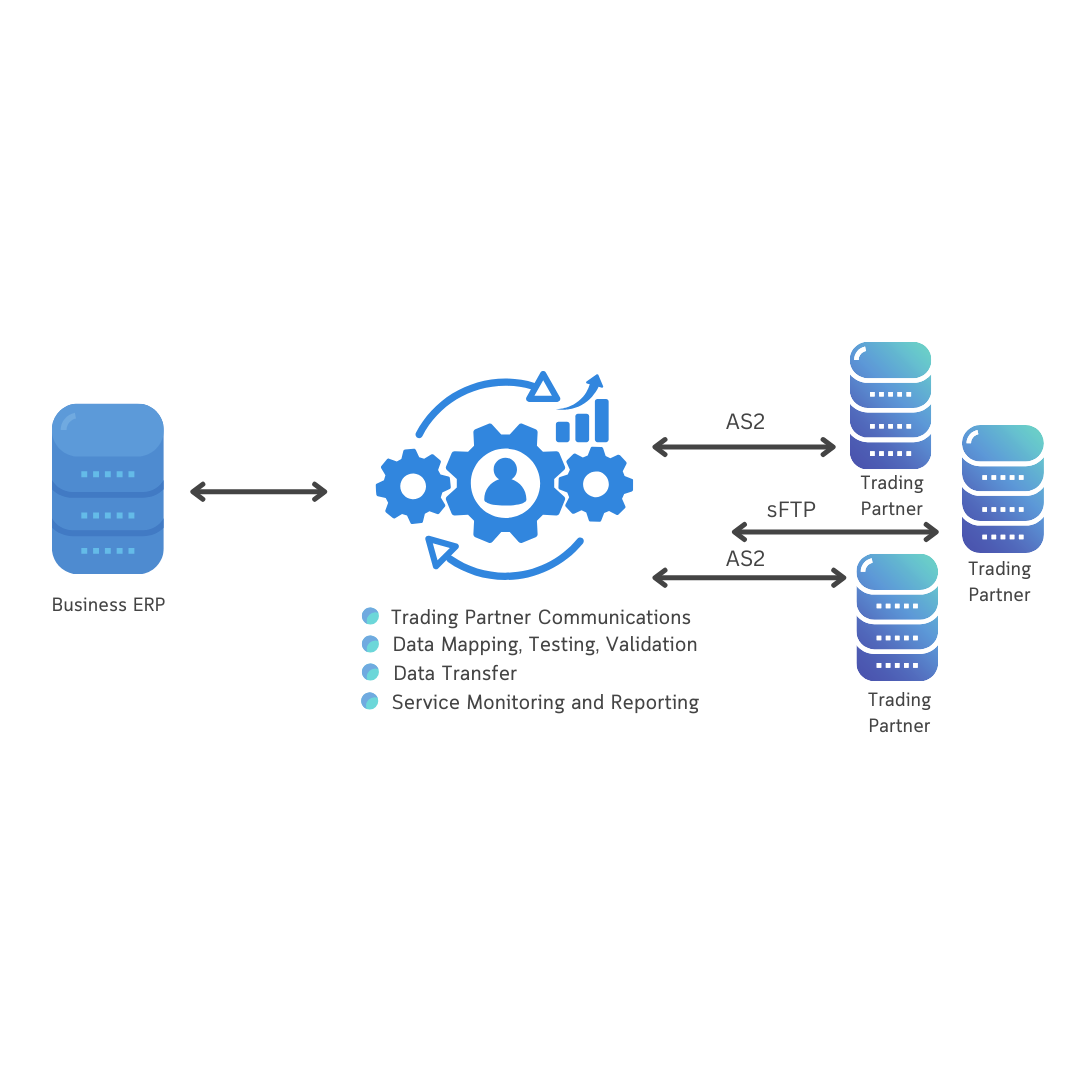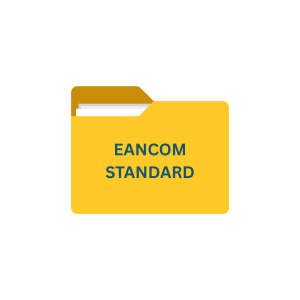Introduction
Do you know why certain businesses look for direct EDI Integration, instead of other traditional EDI integration methods?
Well, this blog will explore
The ‘WHY’,
The pros and cons of direct EDI integration, and
How a third-party EDI providers can offer expertise, technology, and support in implementing direct EDI connections with trading partners.
We’ll also discuss use cases for direct EDI Integration and the benefits for various types of companies.
Electronic Data Interchange (EDI) has become a cornerstone for efficient and accurate business communications in today’s complex supply chains. Through EDI, companies can exchange important documents, like purchase orders and invoices, in standardized formats, enabling seamless EDI automation, reduced errors, and cost savings. As businesses grow, many seek more integrated and efficient ways to handle their EDI processes, which often leads them to consider various EDI Integration methods that allow companies to connect with trading partners for immediate, reliable data exchanges.
Key Takeaways
- Direct EDI connects a business’s internal systems directly with its trading partners for seamless data exchange.
- This approach eliminates the need for intermediaries, reducing transaction times and enhancing control over EDI processes.
- Direct EDI offers real-time data transfer, improving accuracy and responsiveness across the supply chain.
- It’s ideal for companies with high transaction volumes, and less number of trading partners offering long-term cost savings despite initial setup complexity.
- Direct integration supports stronger, more efficient relationships with trading partners through streamlined communication.
Define Direct EDI Integration
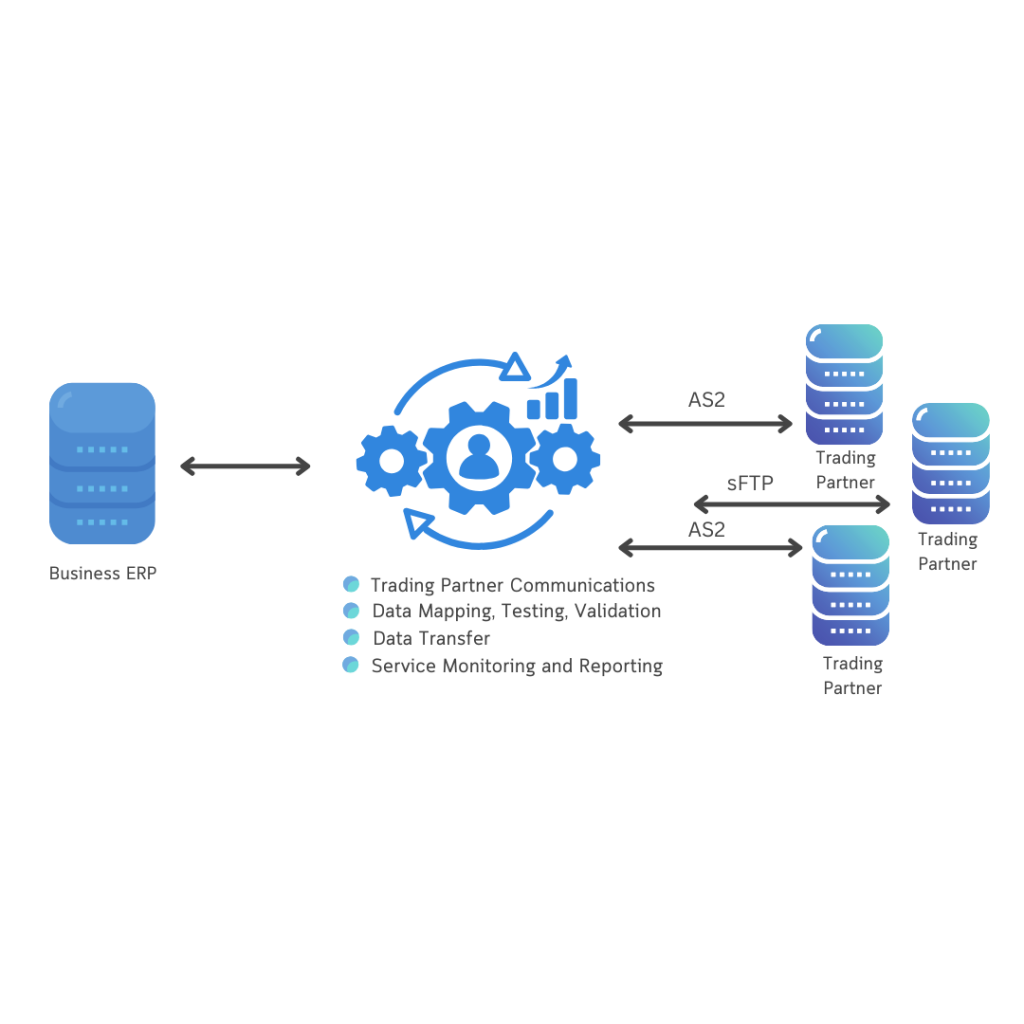
Direct EDI Integration involves establishing a dedicated, one-to-one connection (point-to-point) with trading partners to enable secure and real-time data exchange without using intermediaries. This type of integration is more suitable for companies that only trade with a limited number of trading partners. Direct EDI Integration allows for direct communication, where data flows straight between partners through dedicated protocols, such as AS2 (Applicability Statement 2) or SFTP (Secure File Transfer Protocol).
For companies, this approach provides enhanced control and customization, but it also requires significant technical capabilities. This is where third-party EDI providers come into play. They can simplify the setup, configuration, and ongoing management of EDI integration, making it more accessible for companies without in-house EDI expertise.
Explain the Difference Between Direct EDI Integration and Non Direct EDI Integration
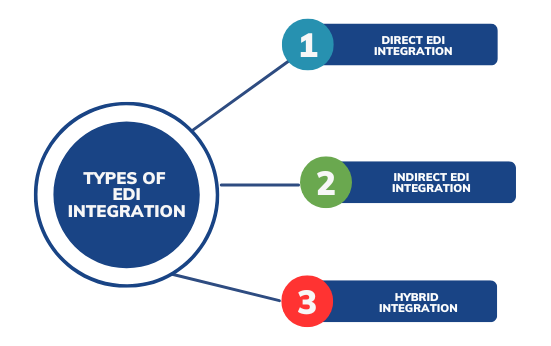
The difference between Direct EDI Integration and Non-Direct EDI Integration lies primarily in the use of intermediaries. In Direct EDI, data is exchanged directly between partners, while in Non-Direct EDI, data flows through a third-party provider or VAN. Here’s a closer look at each:
Direct EDI Integration
Direct EDI Integration involves a one-to-one connection between companies and their trading partners. This approach requires custom configurations and dedicated protocols, providing companies with more control over data handling. With the help of a third-party provider, however, companies can gain access to pre-established frameworks and resources for easier setup and maintenance.
Non-Direct EDI Integration
Non-direct EDI is typically facilitated through a VAN or EDI provider, who acts as the intermediary, routing and translating data between trading partners. This setup reduces technical complexity at the company’s end and is ideal for businesses that do not want to invest in IT infrastructure or additional resources.
Feature |
Direct EDI Integration |
Non-Direct EDI Integration |
|---|---|---|
|
Connection Type |
Direct, one-to-one | Indirect, via a third-party provider |
| Data Control | Complete control over data | Limited control, managed by provider |
| Security | High security with direct protocols (AS2, SFTP, etc.) | Varies depending on the provider’s security measures |
| Cost | Potentially lower transaction costs (no VAN fees) | Additional transaction fees from the EDI provider |
| Customization | Highly customizable | Limited customization, based on provider capabilities |
| Complexity | Higher technical complexity requires setup and management | Less complex, managed by provider |
How Does Direct EDI Integration Work with the Help of Third-Party Providers?
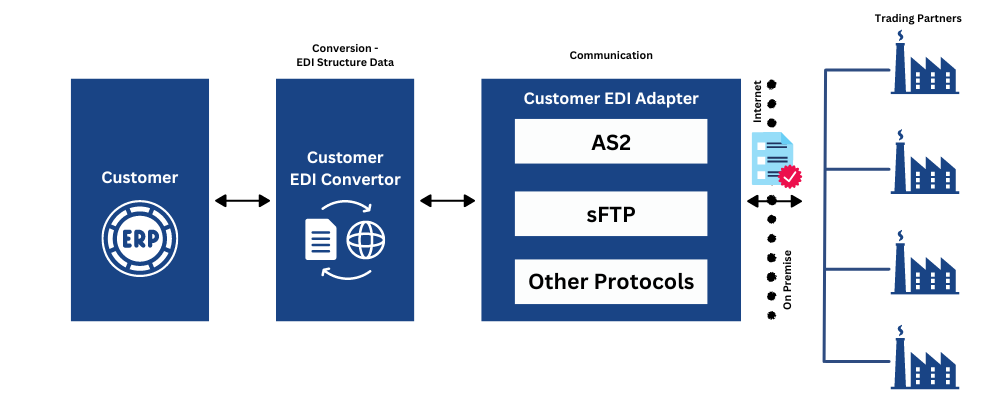
Direct EDI Integration generally involves a series of technical steps to establish secure, reliable connections with trading partners. Here’s how third-party EDI providers streamline and manage these processes:
1. System Compatibility
The first step is to ensure that the trading partners’ internal business systems are compatible and can communicate directly with each other. This may involve the implementation of specific software, APIs, or other integration tools to facilitate the direct connection.
2. Protocol Management and Setting Up a Secure Connection
Once the system compatibility is assisted, the trading partner needs to set up a secure, encrypted connection between their respective systems. This is where a third-party provider like Commport can come in and handle the integration process by using secure communication protocols (AS2, SFTP, FTPS) connections and ensure the confidentiality and integrity of the data being exchanged.
3. Data Mapping and Customization
The next step is data mapping. Your EDI provider can help you with complex data mapping processes, configuring data to align with each partner’s requirements, while offering greater customization capabilities.
4. Automated Data Transfer
Help you set up automated workflows. In this step your EDI provider can enable automated data transfer, sending documents like purchase orders, invoices, ship notices, etc.. directly to trading partners upon creation, minimizing manual steps and reducing processing time.
5. Real-Time Updates
You will start receiving real-time updates and visibility into the status of transactions, and stay up to date with all of the information, which will further help you make informed decisions.
6. Monitoring and Maintenance
In this final phase, your 3rd party EDI provider will monitor the direct EDI integration configuration and provide ongoing support to manage data flow, error resolution, and security updates, helping you to maintain uninterrupted, compliant data exchange
Direct EDI Integration Pros and Cons
Here’s a breakdown of the pros and cons, particularly in the context of provider-managed solutions
Feature |
Pros |
Cons |
|---|---|---|
|
Control |
Full control over data handling and routing | Relies on the provider’s support for configuration and changes |
| Speed | Real-time data exchange with trading partners | Higher setup time initially, especially with multiple partners |
| Cost Efficiency | Eliminates VAN transaction fees; reduces need for in-house expertise | Initial setup costs through provider services |
| Customization | Customized to partner requirements with provider assistance | Some limitations based on provider’s capabilities |
| Security | Higher security: The provider ensures protocol compliance | Responsibility shared with the provider for updates and compliance |
| Scalability | Scalable with the provider’s infrastructure and expertise | May incur additional costs for extensive scaling |
Which Type of Companies Benefit from Direct EDI Integration with Third-Party Providers?

- Large Enterprises: Companies with high transaction volumes and limited number of trading partners, such as some small-town retailers, manufacturers, and logistics providers, often find Direct EDI Integration essential for maintaining efficient, real-time communication with their limited number of trading partners.
- Highly Regulated Industries: Sectors like healthcare, finance, and pharmaceuticals, which require enhanced security and compliance measures, benefit from the additional control that direct integration provides.
- Organizations with Strong IT Infrastructure: Businesses that have an in-house IT team capable of managing the technical aspects of direct EDI connections are well-suited for this approach.
- Cost-Conscious Operations: Businesses looking to reduce their ongoing EDI-related costs, such as service provider fees, can find significant savings through the implementation of a direct EDI integration approach.
- Companies with Long-Term Trading Relationships: For businesses that work with a set group of key trading partners, investing in Direct EDI Integration can streamline transactions and reduce dependency on third-party providers.
- E-commerce Companies: Businesses operating in e-commerce can leverage direct integration for faster order processing, inventory management, and customer fulfillment.
Direct EDI Integration – Use Cases
- Automotive Industry: In the automotive supply chain, manufacturers often have a limited number of Tier 1 suppliers with whom they exchange a high volume of time-sensitive documents, such as purchase orders, shipping notices, and invoices. Direct EDI integration between the manufacturer and these key suppliers can dramatically improve efficiency, reduce errors, and enhance visibility into the supply chain.
- Retail Sector: Large retail chains frequently work with a diverse network of suppliers to stock their shelves. By implementing direct EDI integration with their top vendors, retailers can streamline the order-to-cash process, reduce manual data entry, and ensure accurate information exchange.
- Healthcare Industry: Healthcare organizations, such as hospitals and pharmaceutical companies, often have stringent data security and compliance requirements. Direct EDI integration allows these entities to securely exchange patient records, inventory updates, and other critical information with their insurance providers, pharmacies, and medical equipment suppliers.
- Manufacturing and Distribution: Manufacturers and distributors that routinely exchange large volumes of purchase orders, invoices, and shipping notifications with their suppliers and customers can leverage direct EDI integration to improve operational efficiency, reduce costs, and enhance their overall supply chain visibility.
- Government Agencies: Government agencies that regularly process procurement documents, grant applications, and other official forms can benefit from direct EDI integration with their contractors, vendors, and other government entities to streamline administrative processes and ensure data accuracy.
How Commport Communications Can Help You With Direct EDI Integration?
Commport Communications specializes in assisting companies with EDI Integrations by providing comprehensive solutions that facilitate seamless data exchange. Here’s how Commport can support your Direct EDI journey:
1. Expert EDI Services
Commport with over three decades of experience in EDI implementation, offers a full suite of EDI services, from protocol setup and data mapping to transaction monitoring, allowing companies to implement EDI with minimal internal burden.
2. Security and Compliance
Commport a SCO II Type II compliant company ensures that all connections are secure and meet industry compliance standards, safeguarding your data with reliable protocols like AS2 and SFTP.
3. Customized Solutions
With flexible solutions, Commport tailors each EDI setup to fit your business’s unique requirements, offering a level of customization that helps meet diverse partner specifications.
4. Offer Flexible Pricing
Commport understands the importance of cost-effective solutions, and we can provide flexible pricing models for our EDI integration services to align with your budget and business objectives.
5. 24/7 Support and Proactive Monitoring
Commport provides around-the-clock support and system monitoring, addressing technical issues promptly and ensuring a smooth data exchange experience.
Conclusion
Direct EDI Integration offers companies enhanced control, security, and real-time capabilities in their data exchanges with trading partners. For many businesses, partnering with a third-party EDI provider like Commport Communications can be the optimal way to implement this approach, eliminating the need for significant in-house resources while gaining access to expertise, security, and ongoing support.
With third-party assistance, any type of EDI Integration becomes accessible to companies of all sizes, empowering them to improve operational efficiency, reduce costs, and strengthen their supply chain resilience in today’s dynamic market.
By partnering with Commport Communications, a trusted leader in EDI solutions, you can navigate the implementation and ongoing management of EDI integration with confidence, ensuring that your business can fully capitalize on the benefits this integration approach has to offer.
Commport EDI Solutions
Need Help? Download: EDI Buyers Guide
Unlock the full potential of your supply chain with our comprehensive EDI Buyer's Guide — your first step towards seamless, efficient, and error-free transactions
Frequently Asked Questions
It can lower transaction costs by eliminating the fees associated with VANs or other intermediaries. While there may be upfront costs for setup and configuration, especially if using a third-party provider, the long-term savings on transaction fees and increased efficiency often outweigh initial expenses.
With a third-party provider, the complexity is significantly reduced. Providers manage the technical aspects of protocol setup, data mapping, and partner configuration, making the process smoother. They also offer ongoing support, which minimizes the need for in-house EDI expertise and helps handle any technical challenges.
It offers several advantages, including real-time data exchange, greater control over data flow, enhanced security, and potentially lower costs by eliminating VAN fees. It is also highly customizable, allowing companies to tailor data processes to their specific needs and partner requirements.
A third-party EDI provider can assist by setting up secure, direct connections using protocols like AS2 and SFTP, handling data mapping and customization, and monitoring transactions. Providers offer the expertise and technology required for Direct EDI, helping companies that lack in-house resources manage their EDI systems efficiently.
Yes, it is highly customizable. Third-party providers can tailor data mapping, protocols, and workflows to align with unique business needs, trading partner requirements, and industry standards. This flexibility makes it ideal for businesses with specific data handling needs or those operating in regulated industries where compliance is critical.

